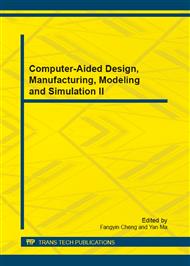p.322
p.327
p.331
p.336
p.341
p.346
p.351
p.355
p.360
Robust Process Design for Continuous Casting Based on Numerical Simulation and Experimental Study
Abstract:
In order to improve design efficiency and reduce design cost, a new method combining numerical simulation with experimental verification was proposed in this study. Firstly, controllable process parameters such as continuous casting speed and cooling water flow rate, are robustly designed according to the numerical simulation results of flow field, process experiments were subsequently done on a newly developed continuous casting machine of lead slice, then the robust optimal design for the continuous casting process were gained. The results show that the cooling water flow significantly affects axial thickness of the lead slice, while the casting speed determines mainly its circumferential thickness. When the casting speed is between 280L/min and 320L/min, and the cooling water flow rate is between 950r/min and 1100r/min at the same time, the axial thickness and circumferential thickness can been kept respectively in1.0±0.03mm and 1.0±0.1mm, which meet the robust design requirements.
Info:
Periodical:
Pages:
341-345
Citation:
Online since:
December 2012
Authors:
Price:
Сopyright:
© 2013 Trans Tech Publications Ltd. All Rights Reserved
Share:
Citation:


